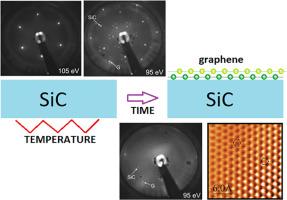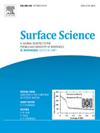根据时间和温度参数逐步研究碳化硅石墨化过程
IF 2.1
4区 化学
Q3 CHEMISTRY, PHYSICAL
引用次数: 0
摘要
这项研究将温度和时间作为高热分解过程中碳化硅表面石墨烯形成的关键参数。测量是在超高真空条件下使用各种实验技术进行的。石墨化过程分为多个阶段,之后对表面化学成分和原子结构进行了详细分析。实验结果表明,尽管石墨化机理和发生这一过程的初始条件的理论是已知的,但应用不同的温度和加热时间会影响所形成的石墨烯层的质量和数量。温度过低或样品退火时间过短会导致硅升华过程效率低下。另一方面,闪蒸过程中温度过高会改变表面结构的可见度,这可能对此类系统的其他研究和潜在应用至关重要。本文章由计算机程序翻译,如有差异,请以英文原文为准。

Step-by-step silicon carbide graphitisation process study in terms of time and temperature parameters
This work investigates the temperature and time as key parameters for graphene formation on the silicon carbide surface during the high thermal decomposition process. Measurements were performed using various experimental techniques under ultra-high vacuum conditions. The graphitisation process was divided into various stages, after which the surface chemical composition and atomic structures were analysed in detail. It has been shown that despite the known theory of graphitisation mechanism and initial condition for occurrence of this process, the application of different temperatures and heating times affect the quality and quantity of formed graphene layers. Applying a temperature too low or annealing the sample for a too short time led to an inefficient silicon sublimation process. On the other hand, too high temperature during flashing modifies the visibility of surface structures, which may be crucial for other investigations and potential applications of such systems.
求助全文
通过发布文献求助,成功后即可免费获取论文全文。
去求助
来源期刊

Surface Science
化学-物理:凝聚态物理
CiteScore
3.30
自引率
5.30%
发文量
137
审稿时长
25 days
期刊介绍:
Surface Science is devoted to elucidating the fundamental aspects of chemistry and physics occurring at a wide range of surfaces and interfaces and to disseminating this knowledge fast. The journal welcomes a broad spectrum of topics, including but not limited to:
• model systems (e.g. in Ultra High Vacuum) under well-controlled reactive conditions
• nanoscale science and engineering, including manipulation of matter at the atomic/molecular scale and assembly phenomena
• reactivity of surfaces as related to various applied areas including heterogeneous catalysis, chemistry at electrified interfaces, and semiconductors functionalization
• phenomena at interfaces relevant to energy storage and conversion, and fuels production and utilization
• surface reactivity for environmental protection and pollution remediation
• interactions at surfaces of soft matter, including polymers and biomaterials.
Both experimental and theoretical work, including modeling, is within the scope of the journal. Work published in Surface Science reaches a wide readership, from chemistry and physics to biology and materials science and engineering, providing an excellent forum for cross-fertilization of ideas and broad dissemination of scientific discoveries.
 求助内容:
求助内容: 应助结果提醒方式:
应助结果提醒方式:


